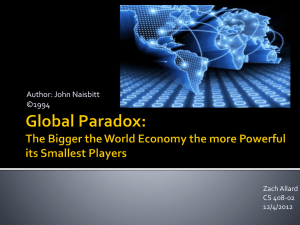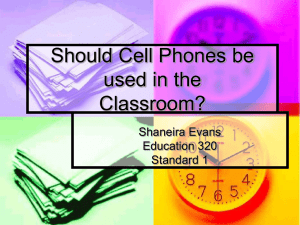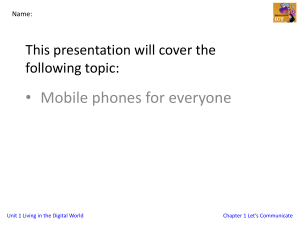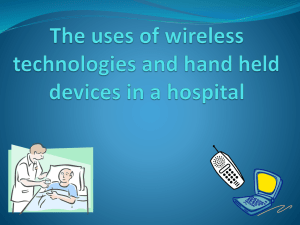U3 Final Paper
advertisement
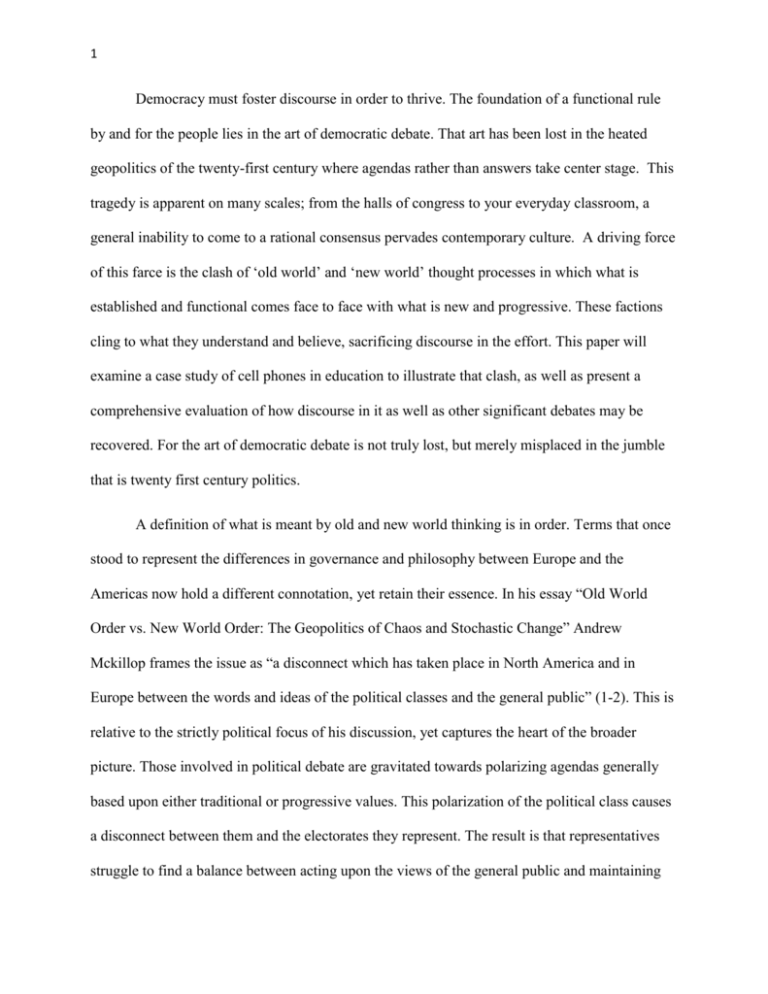
1 Democracy must foster discourse in order to thrive. The foundation of a functional rule by and for the people lies in the art of democratic debate. That art has been lost in the heated geopolitics of the twenty-first century where agendas rather than answers take center stage. This tragedy is apparent on many scales; from the halls of congress to your everyday classroom, a general inability to come to a rational consensus pervades contemporary culture. A driving force of this farce is the clash of ‘old world’ and ‘new world’ thought processes in which what is established and functional comes face to face with what is new and progressive. These factions cling to what they understand and believe, sacrificing discourse in the effort. This paper will examine a case study of cell phones in education to illustrate that clash, as well as present a comprehensive evaluation of how discourse in it as well as other significant debates may be recovered. For the art of democratic debate is not truly lost, but merely misplaced in the jumble that is twenty first century politics. A definition of what is meant by old and new world thinking is in order. Terms that once stood to represent the differences in governance and philosophy between Europe and the Americas now hold a different connotation, yet retain their essence. In his essay “Old World Order vs. New World Order: The Geopolitics of Chaos and Stochastic Change” Andrew Mckillop frames the issue as “a disconnect which has taken place in North America and in Europe between the words and ideas of the political classes and the general public” (1-2). This is relative to the strictly political focus of his discussion, yet captures the heart of the broader picture. Those involved in political debate are gravitated towards polarizing agendas generally based upon either traditional or progressive values. This polarization of the political class causes a disconnect between them and the electorates they represent. The result is that representatives struggle to find a balance between acting upon the views of the general public and maintaining 2 their broad ideologies. This struggle becomes the focal point of their agenda and deters them from engaging in meaningful debate. Take the argument over the place of cellular technology in the contemporary classroom as a case study of this issue on a smaller scale. To provide some background information, what place, if any cell phones have in the American classroom is a hotly debated subject in the educational field. An April 2010 study by the Pew Internet and American Life Project and the University of Michigan found that in schools that allowed students to have cell phones, 71 percent of students sent or received text messages on their cell phones in class. This ubiquitous presence of students cell phones has hence created factions with starkly contrasting views on whether they should be there at all and, if so, how to regulate and even utilize them. However, there is a disconnect between these factions because of an inability to view the issue from each other’s perspectives. Modern students (new world thinkers) consider their vested interest in social media a just impetus for needing their phones in the classroom, a concept understandably difficult to grasp for teachers and administration. Those same teachers and other faculty (the old world thinkers) see the convenience and distracting nature of cell phones as out of place in the labor-intensive, do-it-yourself educational structure they have been raised to set store in. Because the competing factions both focus on the legitimacy of their own testimony, both fail to understand the matter from the other’s perspective. And so, the result is a counter intuitive middle ground in which students have their phones but use them for strictly non-educational means because they are discouraged from using them in the first place. This same middle ground is evident in debates such as same-sex marriage and gun rights. Recent developments in these arguments have brought them to the forefront of the American political arena because of their broad ideological implications. A surge of support for same-sex 3 marriage across the country has made it a highlighted issue on the agendas of many politicians, while an up rise in school shootings has done the same for gun rights and regulations. The teachers and faculties perspective in the cell phone example is comparable to those upholding religiously based marital standards and second amendment rights in the gay marriage and gun rights examples, respectively. The students perspective is likewise comparable to those who proscribe to social progressivism and strict modern safety regulations in the same discussions. The middle ground in these cases are the need for gay couples to travel across state lines in order to get married and the meek regulations on gun ownership in America. In each instance, the democratic process is sacrificed in the interest of each side seeking to get their way, as opposed to seeking a mutually beneficial consensus based upon an understanding of each other’s perspective. Having elaborated upon the issue, a resolution begs discovery. Humorously, a method with which heated political debates may be tackled presents itself in the cell phone example. High School teachers George Engel and Tim Green conducted a case study in which a precalculus class at a high school in New York was encouraged to use their phones in class over the course of a month. Students were required to use the SMS text, video and digital camera functions of their phones. In their essay “Cell Phones in the Classroom: Are We Dialing Up Disaster?” the pair recorded “an observable rise in classroom participation when cell phones were used in the class” (41). Students were able to use their phones as tools for audience response, research, and to display evidence of their work. Engel and Green concluded “the integration of cell phones into the classroom need not be perilous. It is true that schools will need to overcome challenges associated with using these devices; however, with careful planning these challenges can be dealt with” (42). The team went on to posit that in order to mitigate the 4 real and perceived threats of technology use in schools, specific areas needed to be addressed; awareness and knowledge, policies, student education and understanding, and parent involvement. The duo of researchers were able to come to this detailed, comprehensive solution because they did not focus on a particular side of the problem. They were able to look past either established or progressive ways of thinking and focus on the task at hand; the “essential nature” of the issue, so championed my Michael Sandel in his speech “The Lost Art of Democratic Debate.” The essential nature of the debate over cell phones in the classroom is an argument over what the optimal learning environment consists of, and so Engel and Green focused their attention likewise instead of deliberating the broader picture, that is whether or not phones should be allowed in classrooms at all. This illustrates the crux of the problem. In order to reach a solution in which the interests of all parties involved are considered, one’s own interests must be somewhat set aside in order to accurately understand those of the other side. Reverting to those political examples, same-sex marriage and gun rights, inability to resolve these quarrels is based upon the direct opposition of the competing factions. That is the focus; what they disagree on, not how the problem can be resolved. In these political issues as well as most others, the discussion is about who is right and who is wrong, just as it was originally in the cell phone example. The reality is that big problems like these are never that cut and dry. Nobody is right and nobody is wrong, they’re just different. Imagine if an entity such as the US congress or British parliament could conduct some sort of case study comparable to that conducted by Engels and Green. For example, a nationwide survey of married couples asking what their marriage means to them; what its essential nature is. Or a poll of gun owners to establish specifically what firearms they own and how they use them, in order to paint a clearer picture of what rights need 5 protection and what rights require regulation. As Engels and Green argued, “the integration of thought processes need not be perilous” (42). If the holders of old and new ways of thinking could set aside how different they appear on surface level and flesh out the issue just as two ordinary high school teachers did, they may find how much more agreeable the problem can be and end their “ideological food fights”, as Sandel puts it. This essay is not a defamation of our political system, it is an affirmation of the principles upon which it was founded but has sense strayed from. In his farewell speech, President George Washington stated “The alternate domination of one faction over another, sharpened by the spirit of revenge, natural to party dissension, which in different ages and countries has perpetrated the most horrid enormities, is itself a frightful despotism” (1). This quote illustrates the corruptive nature of a focus upon individual thought processes. Although commonly utilized as a knock on the two party system, the sentiments of America’s first great leader are still pertinent today relative to the lost art of democratic debate. Washington’s worst fears have become reality; factions in politics, education, and wherever mass discourse is conducted seek domination as opposed to consensus. People prescribing to generalized old and new world thought processes seek only to assert the legitimacy of their respective ways of thinking because it is what makes sense to them. And so, as a nation and as a world we have deterred the democratic process. It is with pun intended that I suggest we look to thinkers such as high school teachers to recover that process, and end the dissention of old versus new, established versus progressive, and right versus wrong. 6 Works Cited Mckillop, Andrew. Old World Order vs. New World Order: The Geopolitics of Chaos and Stochastic Change; An Elite Odyssey. April 19th, 2014. Washington, George. Presidential Farewell Speech. Ourdocuments.gov: Washington (1-3) September 19, 1796. Engel, G; Geen, T. Cell Phones in the Classroom: Are we Dialing up Disaster?. TechTrends: Linking Research & Practice to Improve Learning. 55, 2, 39-45, Mar. 2011 Sandel, Michael. “The Lost Art of Democratic Debate.” TedTalks (2010). Feb. 2010. Earl, Robert. “Do Cell Phones Belong in the Classroom?”. The Atlantic. May 18, 2012.

